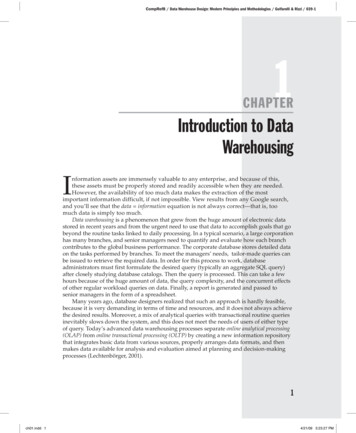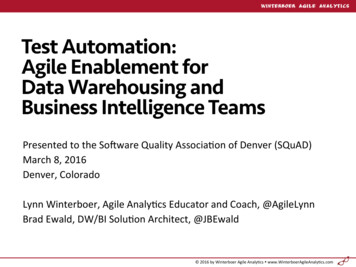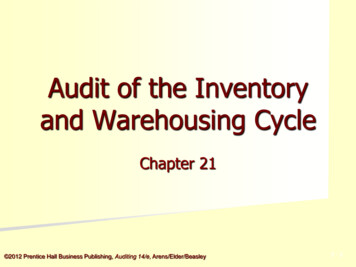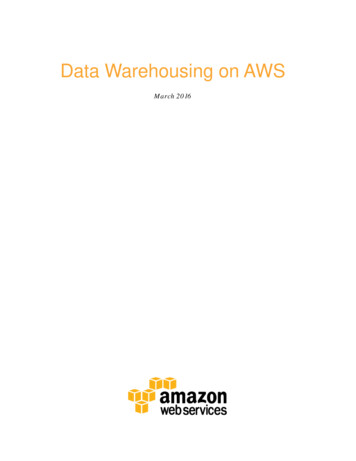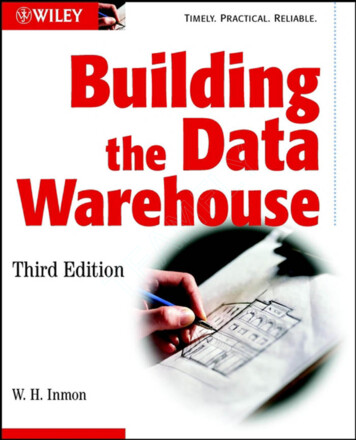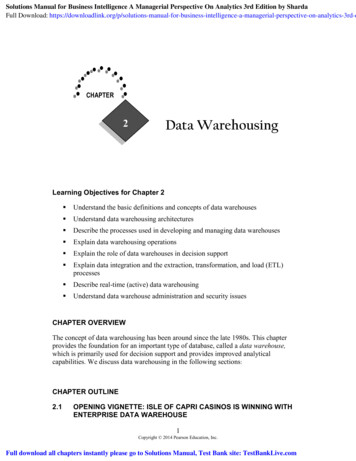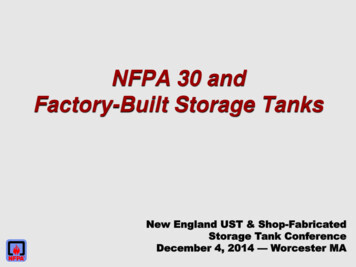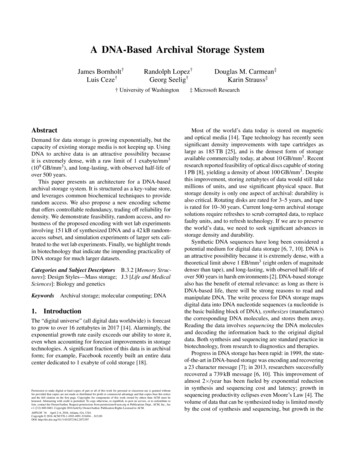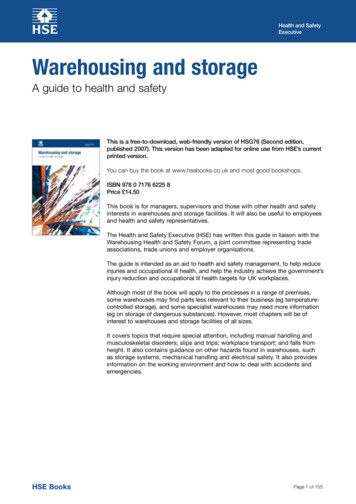
Transcription
Health and SafetyExecutiveWarehousing and storageA guide to health and safetyThis is a free-to-download, web-friendly version of HSG76 (Second edition,published 2007). This version has been adapted for online use from HSE’s currentprinted version.You can buy the book at www.hsebooks.co.uk and most good bookshops.ISBN 978 0 7176 6225 8Price 14.50This book is for managers, supervisors and those with other health and safetyinterests in warehouses and storage facilities. It will also be useful to employeesand health and safety representatives.The Health and Safety Executive (HSE) has written this guide in liaison with theWarehousing Health and Safety Forum, a joint committee representing tradeassociations, trade unions and employer organisations.The guide is intended as an aid to health and safety management, to help reduceinjuries and occupational ill health, and help the industry achieve the government’sinjury reduction and occupational ill health targets for UK workplaces.Although most of the book will apply to the processes in a range of premises,some warehouses may find parts less relevant to their business (eg temperaturecontrolled storage), and some specialist warehouses may need more information(eg on storage of dangerous substances). However, most chapters will be ofinterest to warehouses and storage facilities of all sizes.It covers topics that require special attention, including manual handling andmusculoskeletal disorders; slips and trips; workplace transport; and falls fromheight. It also contains guidance on other hazards found in warehouses, suchas storage systems, mechanical handling and electrical safety. It also providesinformation on the working environment and how to deal with accidents andemergencies.HSE BooksPage 1 of 155
Health and SafetyExecutive Crown copyright 2007First published 1992Second edition 2007ISBN 978 0 7176 6225 8All rights reserved. No part of this publication may be reproduced, stored ina retrieval system, or transmitted in any form or by any means (electronic,mechanical, photocopying, recording or otherwise) without the prior writtenpermission of the copyright owner.Applications for reproduction should be made in writing to:The Office of Public Sector Information, Information Policy Team,Kew, Richmond, Surrey TW9 4DU or e-mail: licensing@opsi.gov.ukThis guidance is issued by the Health and Safety Executive. Following the guidanceis not compulsory and you are free to take other action. But if you do follow theguidance you will normally be doing enough to comply with the law. Health andsafety inspectors seek to secure compliance with the law and may refer to thisguidance as illustrating good practice.Page 2 of 155
Health and SafetyExecutiveContentsIntroduction 4General health, safety and welfare 5Health and safety management 5Managing the workforce 8Occupational health 12Environment and welfare 24Slips and trips 35Electrical safety 42Accidents and emergencies 48Materials handling 53Manual handling 53Mechanical handling 60Vehicles in and around the warehouse 79Work at height 93Storage 101Storage systems 101Automated storage and retrieval systems 118Temperature-controlled storage 125Storage of packaged dangerous substances 135Appendix 1 Warehousing Health and Safety Forum membership 144Appendix 2 Transport hazard diamonds 145Appendix 3 Common types of truck 146References 147Further reading 150Further information 155Warehousing and storage: A guide to health and safetyPage 3 of 155
Health and SafetyExecutiveIntroduction1 This guidance is the second edition of a book that was first published in 1992.It is for people who have management, supervisory or other health and safetyinterests in warehouses and storage facilities. It will also be of value to employeesand their health and safety representatives.2 It is intended as an aid to health and safety management, to help reduce thenumbers of injuries and cases of occupational ill health.3 Although most of the information in this book will apply to processes in a rangeof premises, some warehouses may find parts less relevant to their business (egtemperature-controlled storage), whereas specialist warehouses may find they willrequire additional sources of information (eg on storage of dangerous substances).However, most of the chapters will be relevant to warehouses and storage facilitiesof all sizes. References, further reading and useful websites are listed at the back ofthis book.4 The Health and Safety Executive (HSE) has written this second edition in liaisonwith the Warehousing Health and Safety Forum. The Forum is a joint committeewith representation from trade associations, trade unions and employerorganisations.The challenge5 The Warehousing Health and Safety Forum and HSE encourage all those whomanage or work in warehouses to work towards the government’s injury reductionand occupational ill health targets for UK workplaces.6 If you run a warehouse you can reduce your health and safety risks, and yourcosts, by concentrating health and safety efforts on the main causes of injury andoccupational ill health at your premises. Once you have identified the main causes,which will probably be listed in this book, this guidance will help you to identifywhat action you need to take to reduce injuries and ill health.7 Success is more readily achieved with full involvement of the workforce andtrade union/employee safety representatives when identifying both the problemsand the practical solutions.The priorities8 The Forum and HSE have identified certain priority topics requiring attentionwithin the storage and warehousing industry. They are all covered in this book andinclude: manual handling/musculoskeletal disorders;slips and trips;vehicles in and around the warehouse; andwork at height.9 This book also contains useful guidance on other hazards found in warehouses,such as storage systems, mechanical handling and electrical safety. It also providesinformation on the working environment and how to deal with accidents andemergencies.Warehousing and storage: A guide to health and safetyPage 4 of 155
Health and SafetyExecutiveThe meaning of ‘reasonably practicable’10 Throughout this book there are some references to doing what is ‘reasonablypracticable’ to comply with the law.11 This means that you have to take action to control the health and safety risksin your workplace except where the cost (in terms of time and effort as well asmoney) of doing so is ‘grossly disproportionate’ to the reduction in the risk. You canwork this out for yourself, or you can simply apply accepted good practice.General health, safety andwelfareHealth and safety management12 Warehousing and storage cover a wide range of activities that can result invarious hazards and risks. Effective health and safety management involves you,the employer, looking at the risks that arise in the workplace and then puttingsensible health and safety measures in place to control them. By doing this you canprotect your most valuable asset, your employees, as well as members of thepublic from harm. You will also help protect your premises, goods, equipment andreputation.13 Accidents, injuries and ill health are reported to the health and safety enforcingauthorities under the Reporting of Injuries, Diseases and Dangerous OccurrencesRegulations 1995 (RIDDOR). Paragraphs 332–337 give more information onRIDDOR reporting requirements.The main cause of injuries in warehousingMajor injuries14 Around a quarter of major injuries (broken bones, injuries requiringhospitalisation for more than 24 hours etc) in the warehousing industry are causedby workers slipping or tripping. In the past, a slip or trip accident may not havebeen viewed as seriously as an accident involving a fork-lift truck. However, it isclear from the pattern of major injuries that workers who slip or trip are sustainingserious injuries from the fall or from impact with objects or structures.15 Manual handling, being hit by moving or falling objects and falls from heightalso cause a significant number of major injuries. See Figure 1.Over-3-day absence16 The manual handling of loads is the main cause of reported over-3-day injuries.As well as being the prime cause of major injuries, slips and trips are also asignificant cause of over-3-day injuries. See Figure 2.Warehousing and storage: A guide to health and safetyPage 5 of 155
Health and SafetyExecutiveFigure 1 Causes of major injuries in storage andwarehousing (2005/06)26%Figure 2 Causes of over-3-day absence injuries in storageand warehousing (2005/06)Key:4%Slip or trip9%18%8%Manual handlingFalls from heightHit by moving, falling object18%9%5%5%45%Hit by moving vehicle10%16%Hit something fixed or stationary13%14%Other kinds of accidentHealth and safety policy17 A health and safety policy statement is a starting point to managing health andsafety in the workplace. It sets out how health and safety will be managed in yourorganisation – it shows who does what, and when and how they do it. If you havefive or more employees, you will need to have a written health and safety policystatement.Managing health and safety18 Warehousing is a complex industry that can expose workers to a multitude ofrisks; health and safety should be proactively managed just like any other part ofthe business.19 The Management of Health and Safety at Work Regulations 19991 requireemployers to put in place appropriate health and safety arrangements. This meanshaving an effective health and safety management system. The complexity of thissystem should reflect the organisation’s activities.20 Steps to successful health and safety management include: identifying the key health and safety priorities within a business;concentrating efforts on these priorities;assessing the risks to employees and others;eliminating risks where possible. Where risks can’t be eliminated, they shouldbe reduced to an acceptable level;using safe systems of work;providing the workforce with adequate information and training;involving the workforce and health and safety representatives in decisionmaking on health and safety issues; andregularly reviewing performance.21 Successful health and safety management HSG652 gives more information onhealth and safety management systems.Risk assessment22 The first step in managing health and safety is to identify the priorities – ie tocarry out a risk assessment. This book will help as it covers the recognised mainhazards in warehouses. It is also important to consider additional hazards specificto a site that may also need attention.Warehousing and storage: A guide to health and safetyPage 6 of 155
Health and SafetyExecutive23 Risk assessment is an important step in protecting your workers and yourbusiness, as well as complying with the law. It helps you focus on the risks thatreally matter – the ones with the potential to cause real harm. You are legallyrequired to assess the risk in your workplace so that you can put in place a plan tocontrol them.24 A risk assessment is simply a careful examination of what in your work couldcause harm to people, so that you can weigh up whether you have taken enoughprecautions or should do more to prevent harm. Workers and others have a right tobe protected from harm caused by a failure to take reasonable control measures.25 The law does not expect you to eliminate all risk, but you are required toprotect people ‘so far as is reasonably practicable’.26 When thinking about your risk assessment, remember: a hazard is anything that may cause harm, such as chemicals, electricity,working from ladders, an open drawer etc; the risk is the chance, high or low, that somebody could be harmed by theseand other hazards, together with an indication of how serious the harm couldbe.27 Risk assessment can be broken down into five steps:3StepStepStepStepStep12345identify the hazards;decide who might be harmed and how;evaluate the risks and decide on precautions;record your findings and implement them; andreview your risk assessment and update if necessary.28 If you employ five or more people you must keep a record of the significantfindings of your assessment. The record should be fit for purpose – paperwork is ameans to an end rather than an end in itself. Examples of risk assessments arepublished on the risk pages of HSE’s website; these help you identify what isexpected in practice.29 Many risks in a warehouse may already be well controlled, eg the correctindustrial trucks may be used and the drivers correctly trained, but you should alsoconsider other issues such as supervision, monitoring and maintenance.30 Workers should be actively involved in the risk assessment process.Investigating accidents and incidents31 Investigating any accidents that occur will help you identify further actions thatyou need to take. The outcome of an investigation can also help with a review ofrisk assessments.32 Sometimes it is obvious what action needs to be taken. Sometimes accidents/incidents can be complex and need to be more thoroughly investigated, eg bylooking at systems of work. The procedure in Checklist 1 can be used toinvestigate accidents and incidents.33 Investigating accidents and incidents: A workbook for employers, unions, safetyrepresentatives and safety professionals HSG2454 gives more information onaccident investigation.Warehousing and storage: A guide to health and safetyPage 7 of 155
Health and SafetyExecutiveChecklist 1: Investigating accidents and incidentsCheck what happened: find out about the circumstances leading up to the accident/incident; identify the hazards that contributed to the accident/incident, eg:–– plant, equipment, tools or substances in use;–– work environment (such as floor surface, lighting, temperature);–– the way the work is organised (who is doing what and when); and–– training and skills of those involved.Prevent the accident/incident happening again: identify what has already been done to minimise the risk; decide on additional precautions required to prevent similar accidents/incidents; ensure the additional precautions are implemented; and review the new precautions to ensure they remain effective.Keep records of any investigations you carry out.Managing the workforce34 The workforce is a valuable asset and your workers are directly involved in theday-to-day running of your business. Effective management of the workforce is vitalto good health and safety management.Selecting workers35 Before selecting someone for a job, you should identify if the job has anyspecial demands. You should then ensure that the person applying for the job canmeet these demands. Also consider what arrangements can be put in place toaccommodate a worker’s requirements.Training36 All employees should have basic training in health and safety. All warehouseworkers should have adequate training in the hazards associated with their workand within the warehouse, along with the precautions to take. For example, alloperators of work equipment, including vehicles, should be suitably trained in thehazards of the equipment they use and the precautions that apply as well as safeoperation.37 Managers and supervisors also require suitable training and should becompetent for their role.38 Consider any specific legal requirements for job training, eg requirements forfirst-aiders (see paragraphs 323–331) or for fork-lift truck drivers (seeparagraphs 444–452).Warehousing and storage: A guide to health and safetyPage 8 of 155
Health and SafetyExecutive39 You can obtain information and advice on training from: the supplier of the material, substance or equipment;training centres or colleges of further education;trade associations;trade unions;HSE;local authority environmental health departments;professional bodies (eg the Institution of Occupational Safety and Health);voluntary bodies (eg the Royal Society for the Prevention of Accidents, theBritish Safety Council); skills councils such as Skills for Logistics.Refresher training40 Employee competence can decline if skills are not used regularly (egemergency procedures or where an employee deputises for another). Trainingtherefore needs to be repeated periodically to ensure continued competence.Checklist 2: Training programmeConsider the following when preparing a typical training programme:Organisation Will training be ‘on’ or ‘off’ the job? Who will do the training? (Will they be competent?) Who will supervise the training? (Will they be competent?) How will the trainees’ competence be assessed? What will the trainee be competent in at the end of the training? What records will be kept? Who will keep the records?Basic instructionFor each task, prepare a list of all the points training should cover, eg: the method of work; the equipment or substance used; how the equipment or substance works and what it does; any dangers that are associated with its use, including accidental spillage; any safety precautions needed, and how they protect the user; how to clean equipment safely; what to do if equipment seems faulty; and what personal protective equipment to wear.Supervised working Make sure the supervisor is competent for the training task. Set the trainee to work under close supervision. Ensure the supervisor has the time and knowledge to supervise effectively. Ensure the supervisor watches closely to see that dangerous practices do notdevelop.Warehousing and storage: A guide to health and safetyPage 9 of 155
Health and SafetyExecutiveSpecific groups of workersYoung people41 In addition to an employer’s general duty to assess the health and safety risks,there are particular responsibilities towards young people. These are: to assess risk to all young people under 18 years of age, before they startwork; to ensure the risk assessment takes into account inexperience, and lack ofawareness of existing or potential risks; to introduce control measures to eliminate or minimise the risk, so far as isreasonably practicable.42 There are specific risks that you have to consider within a risk assessment foryoung people, these include risks to health from extreme cold or heat, noise, orvibration. Young people should not be employed for work that is beyond theirphysical or psychological capacity.43 You must let the parents/guardians of any students (and employees) below theminimum school leaving age know the key findings of the risk assessment and thecontrol measures taken before young people start work or work experience. Seethe Young people at work section of the HSE website for more information.Pregnant and breastfeeding workers44 When you are undertaking risk assessments, consider any specific risks towomen of childbearing age who could become pregnant, along with any risks tonew and expectant mothers. This is a requirement of the Management of Healthand Safety at Work Regulations 1999.45 Employees do not have to inform their employer that they are pregnant orbreastfeeding, but it is important (for their own and their child’s health and safety) toprovide their employer with written notification as early as possible.46 When you receive written notification that one of your employees is pregnant oris breastfeeding, you must carry out a specific risk assessment. Take steps toensure that they are not exposed to any significant risks. Some of the morecommon risks you should consider are: lifting/carrying heavy loads;standing or sitting for long lengths of time;work-related stress;workstations and posture;long working hours; andexcessively noisy workplaces.47 Where the risk assessment identifies risks, temporarily adjust the workingconditions and/or hours of work. If it is not reasonable to do so, or would not avoidthe risk, then: offer suitable alternative work (at the same rate of pay) if available, or, if that isnot feasible; suspend the individual from work on paid leave for as long as necessary toprotect the health and safety of the individual and their child.48 See A guide for new and expectant mothers who work INDG3735 for furtherinformation.Warehousing and storage: A guide to health and safetyPage 10 of 155
Health and SafetyExecutiveAgency workers49 Employment agencies and warehouse operators who hire from agencies have ashared duty to protect the health and safety of agency workers. They should cooperate and co-ordinate with each other to ensure that the risks to agency workersare adequately managed.50 Where agency workers are used, you should consider them within your riskassessments. Take into account their lack of experience and familiarity with thework. The same health and safety standards that apply to permanent employeesshould also apply to agency workers.51 An employer’s heath and safety duties towards agency staff cannot be passedto another party by civil contracts. Employment agencies and warehouseemployers should ensure that there is a clear understanding of who is responsiblefor the day-to-day management of the health and safety of agency staff; it isrecommended that this agreement is recorded in writing.52 You can find more information on agency workers on the HSE website andDepartment of Trade and Industry (DTI) Business Link website (see Furtherinformation).Workers who do not have English as their first language53 The warehousing industry employs many workers who do not have English astheir first language. You should ensure that there are suitable methods in place toclearly communicate training and instructions to these groups of employees, as wellas adequate supervision arrangements.Contractors54 If contractors are working on site, eg carrying out racking maintenance or doingroof repairs, it is not sufficient to assume that they are competent and workingsafely.55 Contractors’ competence and experience should be established beforecontracting them and once they are on site, make sure that they are in fact workingto a safe system of work. You should also make sure that the activities carried outby the contractor will not endanger other employees, eg an engineer servicing aconveyor could remove a guard for access and not replace it, or an electricianworking at height could drop a tool onto workers below.56 See Working together: Guidance on health and safety for contractors andsuppliers INDG2686 for more information.Involving employees’ health and safety representatives57 Workers are the people who know the most about the jobs they do. Therefore,it makes sense that they should play an active part in developing safe, practicalsystems of work. That is why there is a legal duty to consult with workers and/ortheir representatives.58 There is evidence that points to the advantages of involving workers in healthand safety risk management. By introducing worker involvement, you will bemaking a significant contribution to: developing a positive health and safety culture;reducing accidents and ill health and their associated costs;meeting customer demands and maintaining credibility; andcomplying with legal requirements.Warehousing and storage: A guide to health and safetyPage 11 of 155
Health and SafetyExecutive59 In short, workplaces where workers are involved in taking decisions abouthealth and safety are safer and healthier workplaces.60 To encourage effective worker involvement, you should make sure that yourhealth and safety policy statement specifies that everyone has a positive role toplay. It should give a clear commitment by senior management to actively involvethe workforce – including part-time and agency workers – as part of a developinghealth and safety culture.61 Where there is a recognised trade union, you must consult with the safetyrepresentatives elected by the trade union. Trade union safety representatives arean important source of health and safety knowledge and should be activelyengaged in any scheme to build worker involvement. They can play a key role inmotivating workers to participate. Their trade union training as safetyrepresentatives and access to independent advice on health and safety mattersmean that they can add value to your health and safety management.62 See also Consulting employees on health and safety: A guide to the lawINDG232.7Employees’ responsibilities63 Employees also have health and safety responsibilities for themselves andcolleagues. They must: work in accordance with the training and instruction given by their employer; report situations they believe to be unsafe; and not do anything that could endanger themselves or other people.Occupational health64 In 2005/06 there were 24 million working days lost due to workplace ill health inthe UK. The most common causes were stress-related illness (10.5 million days)and musculoskeletal disorders (9.4 million days). These are also the main causes ofoccupational ill health within the storage and warehousing industry.65 Occupational ill health costs: employers, through the loss of experienced staff and reduced productivity ofindividuals; society, where people leave work and go on to long-term incapacity benefits;and individual workers and their families, due to the long-term effects of chronichealth problems.66 Occupational health can be more difficult to manage than safety and as a resultfar more workers suffer from work-related ill health than accidents. Usually thecauses and consequences of poor safety at work are immediate and are relativelyeasy to deal with. Work-related causes of ill health can be more difficult to spot. Itcan often take some time for symptoms to develop, so the connection betweencause and effect is less obvious.Warehousing and storage: A guide to health and safetyPage 12 of 155
Health and SafetyExecutive67 For the most common occupational health problems, such as back pain, theremay be other causes that have nothing to do with work. Workers may also beunwilling to admit themselves that they have work-related health problems becauseof fears about their job or the stigma attached to certain types of illness.68 Knowledge about the most effective solutions to work-related health problemscan also be limited. Some of the larger businesses in the industry employ specialistoccupational health staff, usually with a medical background. However, for mostorganisations, especially small businesses, access to reliable medical advice onoccupational health is very limited.69 Improving occupational health management is not as difficult as many peoplethink. Businesses don’t need to set up specialist departments or pay for expensivemedical advisors to control it on a day-to-day basis. The vast majority ofoccupational ill health results from a few basic causes. These can be controlled bymanagement and workers working together to identify practical control measuresthat are suitable for their workplace.Managing occupational health70 There are three broad issues to consider when developing an effectiveoccupational health management programme. These are: preventing and managing the risk; rehabilitation; and health promotion.71 There is a legal and moral responsibility on the employer to do what isreasonably practicable to prevent work-related ill health. As well as complying withgeneral duties under the Health and Safety at Work etc Act 1974, some morespecific legal duties are relevant to common health problems in the workplace, egthe Control of Substances Hazardous to Health Regulations 2002 (COSHH) dealwith hazardous chemicals, dusts and fumes.Preventing and managing the risk72 As with any health and safety issue, a hierarchy of control measures should befollowed. Where possible, removing the hazard is the best option. Reliance onindividual protection through personal protective equipment (PPE) should normallybe a last resort.73 Identifying work-related health risks may not be straightforward, but there are anumber of sources you can use – see paragraphs 74–76. HSE has also producedguidance on the main issues, some of this is available through the HSE website.Monitoring sickness absence74 Attendance management has become a major issue for many employers.Information obtained from more tightly managed attendance can be very useful inidentifying possible work-related health problems. If there are certain jobs or partsof the workplace where absence is higher, this may be an indication of a problem.High levels of back pain or upper-limb disorder (ULD) symptoms may be associatedwith certain types of work. However, you may need to exercise some caution whenanalysing absence patterns, and remember that some personal information isprotected by data protection laws. Paragraphs 145–148 give more information onmanaging sickness absence.Warehousing and storage: A guide to health and safetyPage 13 of 155
Health and SafetyExecutiveHealth surveillance75 Where there is a clearly identifiable disease or condition linked directly to thework and there is a reliable way of monitoring to detect the condition, healthsurveillance might be necessary. Examples include hearing tests for people workingwhere there is loud noise and a risk of damage to hearing. Any health recordscollected through health surveillance must be kept confidential and workers mustknow what surveillance is being done and why.Listening to the workers76 A lot of information can be gained from the workers themselves, but rememberthat workers may be reluctant to admit to health problems. However, there areways of gathering their experience or collecting their opinions that can protectconfidentiality and ensure a more open response. Trade union safetyrepresentatives are often trained in the use of techniques such as body mapping,surveying with discomfort questionnaires, etc.Rehabilitation77 Even if you are doing everything possible to prevent people being made ill bywork, there will still be occasions when someone does become ill. The initial causeof their health problem may not be work-related but the consequences st
21 Successful health and safety management HSG652 gives more information on health and safety management systems. Risk assessment 22 The first step in managing health and safety is to identify the priorities – ie to carry out a risk assessment. This book will hel
